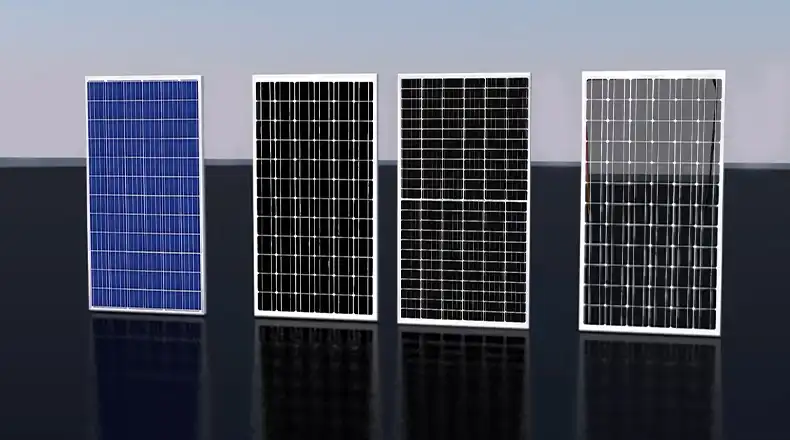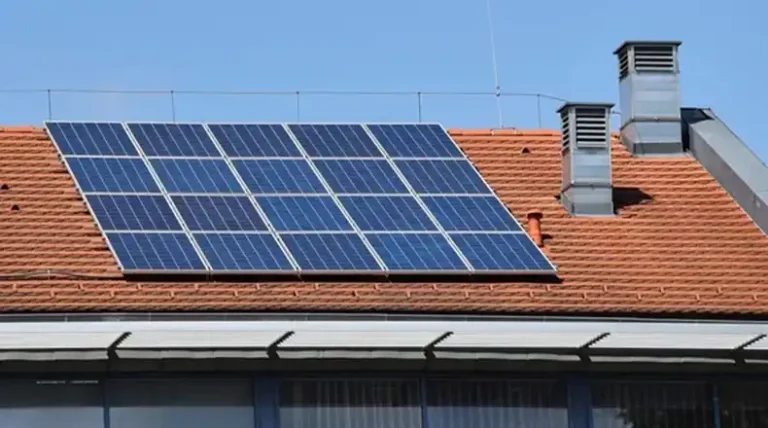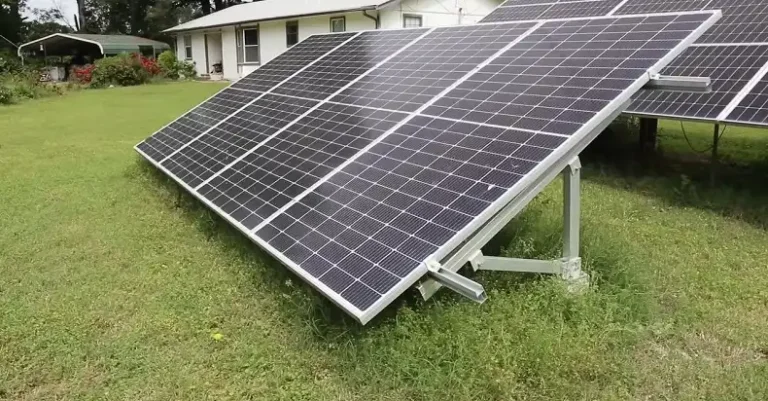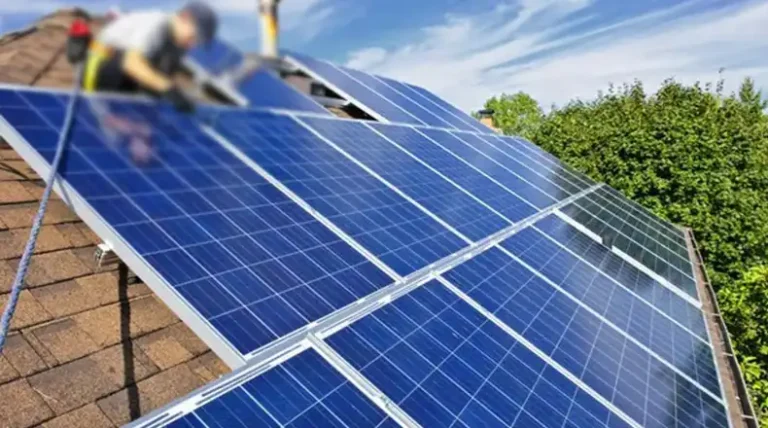Different Types of Solar Panels (Benefits, Drawbacks, Applications)
Solar panels are a great way to generate clean, renewable energy for your home or business. But with so many different types of solar panels on the market, it can be tough to know which ones are right for you.
In this article, we’ll take a look at the four main types of solar panels: monocrystalline, polycrystalline, thin-film, and PERC. We’ll discuss the features, benefits, and drawbacks of each type, so you can make an informed decision about which ones are best for your needs.

1. Monocrystalline Solar Panels
Monocrystalline solar panels are made from a single crystal of silicon. This gives them a uniform, dark blue appearance and makes them the most efficient type of solar panel on the market today. Monocrystalline solar panels can convert up to 22% of sunlight into electricity, while other types of solar panels, such as polycrystalline and thin-film solar panels, have lower efficiencies.
Monocrystalline solar panels are also the most expensive type of solar panel. However, their high efficiency and long lifespan make them a good investment for homeowners and businesses looking to maximize their solar energy savings.
Benefits of monocrystalline solar panels:
- Highest efficiency of any type of solar panel
- Produce more electricity than other types of solar panels
- Save more money on energy bills
- Last longer than other types of solar panels
Drawbacks of monocrystalline solar panels:
- Most expensive type of solar panel
- Require a lot of sunlight to produce electricity
Applications of monocrystalline solar panels:
Monocrystalline solar panels are a good choice for a wide range of applications, including:
- Residential solar power systems
- Commercial solar power systems
Monocrystalline solar panels are especially well-suited for applications where space is limited, such as on rooftops or in solar carports. This is because they can produce more electricity per square foot than other types of solar panels.
Overall, monocrystalline solar panels are a good investment for homeowners, businesses, and utilities looking to maximize their solar energy savings. They have the highest efficiency of any type of solar panel, and they can be used in a wide range of applications.
2. Polycrystalline Solar Panels
Polycrystalline solar panels are made from multiple crystals of silicon. This gives them a speckled, blue appearance and makes them less efficient than monocrystalline solar panels, but also less expensive. Polycrystalline solar panels can convert up to 17% of sunlight into electricity, while monocrystalline solar panels can convert up to 22%.
Polycrystalline solar panels are a good option for homeowners and businesses on a budget. They’re also a good choice for areas with limited sunlight, as they can still produce electricity in low-light conditions.
Benefits of polycrystalline solar panels:
- More affordable than monocrystalline solar panels
- Can still produce electricity in low-light conditions
Drawbacks of polycrystalline solar panels:
- Less efficient than monocrystalline solar panels
- Require more space than monocrystalline solar panels to produce the same amount of electricity
Applications of polycrystalline solar panels:
Polycrystalline solar panels are a good choice for a wide range of applications, including:
- Residential solar power systems
- Commercial solar power systems
- Utility-scale solar power systems
- Rooftop solar panels
- Ground-mounted solar panels
- Solar carports
- Solar generators
Polycrystalline solar panels are especially well-suited for applications in areas with limited sunlight, such as in northern climates or under shady trees.
Overall, polycrystalline solar panels are a good investment for homeowners and businesses on a budget. They’re also a good choice for areas with limited sunlight. However, it’s important to note that they’re less efficient than monocrystalline solar panels, so you’ll need to install more panels to produce the same amount of electricity.
3. Thin-Film Solar Panels
Thin-film solar panels are made from a thin layer of photovoltaic material, such as cadmium telluride (CdTe) or copper indium gallium selenide (CIGS). This makes them the least efficient type of solar panel, with efficiencies of up to 14%, but also the most lightweight and flexible.
Thin-film solar panels are a good option for homeowners and businesses with limited roof space or who need to install solar panels on a curved surface. They’re also a good choice for areas with high temperatures, as they perform well in hot weather.
Benefits of thin-film solar panels:
- Lightweight and flexible, making them ideal for curved surfaces
- Perform well in hot weather
Drawbacks of thin-film solar panels:
- Least efficient type of solar panel
- Require more space than monocrystalline or polycrystalline solar panels to produce the same amount of electricity
Applications of thin-film solar panels:
Thin-film solar panels are a good choice for a variety of applications, including:
- Rooftop solar panels
- Building-integrated photovoltaics (BIPV)
- Solar carports
- Solar generators
- Solar backpacks
- Solar tents
Thin-film solar panels are especially well-suited for applications where weight and/or flexibility are important factors, such as in portable solar generators or solar backpacks. They’re also a good choice for applications in areas with high temperatures, such as in the desert.
4. PERC Solar Panels
PERC solar panels, also known as passivated emitter and rear contact solar panels, are a type of monocrystalline solar panel with an additional passivation layer on the back of the cell. This layer helps to reduce reflection and increase efficiency.
PERC solar panels are the most efficient type of solar panel on the market today, with efficiencies of up to 22%. This means that they can convert more sunlight into electricity than other types of solar panels, such as polycrystalline or thin-film solar panels.
PERC solar panels are also more expensive than other types of solar panels. However, their high efficiency makes them a good investment for homeowners and businesses looking to maximize their solar energy savings.
Benefits of PERC solar panels:
- Highest efficiency of any type of solar panel
- Produce more electricity than other types of solar panels
- Save more money on your energy bills
Drawbacks of PERC solar panels:
- Most expensive type of solar panel
Applications of PERC solar panels:
PERC solar panels are a good choice for a wide range of applications, including:
- Residential solar power systems
- Commercial solar power systems
Final Thoughts
Choosing the right solar panel for your home is a significant decision. It’s not just about saving on your energy bills; it’s about making a sustainable choice for the planet. Each type of solar panel has its strengths and weaknesses, so your choice will depend on your budget, space, and personal preferences.
In the end, whether you opt for the efficiency of monocrystalline, the affordability of polycrystalline, the adaptability of thin film, or the cutting-edge technology of PERC panels, you’re taking a step towards a greener future. So, go ahead, harness the power of the sun, and let your home bask in the glory of clean energy.
People Also Ask – PAA
What is the lifespan of monocrystalline solar panels?
Monocrystalline solar panels typically have a lifespan of more than 25 years, making them a long-term investment in clean energy.
Are thin-film solar panels suitable for residential use?
While thin-film solar panels offer versatility, they are less efficient than crystalline panels, so they may not be the best choice for residential use if efficiency is a top priority.
Do polycrystalline panels perform well in low-light conditions?
Polycrystalline panels are less efficient in low-light conditions compared to monocrystalline panels. However, they can still generate electricity but at a slightly lower rate.
Can I combine different types of solar panels in a single installation?
It’s possible to combine different types of solar panels, but it can be complex and may require additional equipment to ensure compatibility and efficiency.






